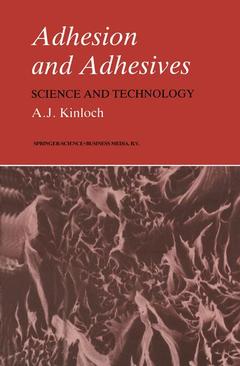Description
Adhesion and Adhesives, Softcover reprint of hardcover 1st ed. 1987
Science and Technology
Author: Kinloch Anthony J.
Language: English
Subject for Adhesion and Adhesives:
Publication date: 12-2010
442 p. · 15.5x23.5 cm · Paperback
442 p. · 15.5x23.5 cm · Paperback
Description
/li>Contents
/li>
Over the last decade, or so, the growth in the use of adhesives, especially in ever more technically demanding applications, has been rapid and many major developments in the technology of adhesives have been reported. This growth has also led to attention being focused on somewhat more basic studies of the science of adhesion and adhesives, and in recent years our level of fundamental knowledge concerning the formation and mechanical performance of adhesive joints has increased dramatically. Such studies have, of course, been aided greatly by the development of the tools at the disposal of the investigators. For example, specific surface analytical techniques, such as X-ray photoelectron and secondary-ion mass spectroscopy, and the increasingly sophisticated methods of stress analysis and fracture mechanics have been put to good use in furthering our understanding of the science of adhesion and adhesives. The present book attempts to review the multidisciplined subject of adhesion and adhesives, considering both the science and technology involved in the formation and mechanical performance of adhesive joints. The author would like to thank his friends and colleagues for useful discus sions and help in the preparation of this book. I am particularly grateful to P. Cawley, J. Comyn, W. A. Lees, A. C. Roulin-Moloney, W. C. Wake, J. G. Williams and R. J. Young who have read and commented on various chapters and P. Farr for preparing the diagrams.
1 Introduction.- Bibliography of general background books.- 2 Interfacial contact.- 2.1 Introduction.- 2.2 Surface tension.- 2.3 Wetting equilibria.- 2.4 Surface and interfacial free energies.- 2.5 Kinetics of wetting.- 2.6 The bonding operation.- 2.7 Concluding remarks.- References.- 3 Mechanisms of adhesion.- 3.1 Introduction.- 3.2 Mechanical interlocking.- 3.3 Diffusion theory.- 3.4 Electronic theory.- 3.5 Adsorption theory.- 3.6 Concluding remarks.- References.- 4 Surface pretreatments.- 4.1 Introduction.- 4.2 Low-energy surfaces.- 4.3 High-energy surfaces.- 4.4 Concluding remarks.- References.- 5 Hardening of the adhesive.- 5.1 Introduction.- 5.2 Hardening by solvent or dispersing medium removal.- 5.3 Hardening by cooling.- 5.4 Hardening by chemical reaction.- 5.5 Non-hardening adhesives.- 5.6 Concluding remarks.- References.- 6 Mechanical behaviour of adhesive joints.- 6.1 Introduction.- 6.2 Common joint designs.- 6.3 Standard test methods.- 6.4 Stresses in adhesive joints.- 6.5 Non-destructive testing.- 6.6 Concluding remarks.- References.- 7 Fracture mechanics of adhesive joints.- 7.1 Introduction.- 7.2 Theoretical considerations.- 7.3 Experimental considerations.- 7.4 Typical values of Gc and Kc.- 7.5 Effect of joint geometry.- 7.6 Effect of rate and temperature.- 7.7 Concluding remarks.- References.- 8 The service life of adhesive joints.- 8.1 Introduction.- 8.2 Fatigue.- 8.3 Environmental attack.- 8.4 Concluding remarks.- References.- Notations.- English alphabet.- Greek alphabet.- Abbreviations.- Author index.
© 2024 LAVOISIER S.A.S.

